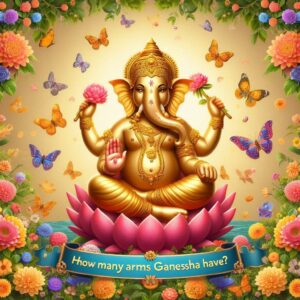Table of Contents
Toggle
In the days of yore, after the marriage of Goddess Parvati to Lord Shiva, Parvati once sat in a lush grove with her companions, enjoying light-hearted conversation. During this time, a fit of laughter escaped her, and from this laughter emerged a majestic and towering figure. Startled by his sudden appearance, Parvati asked the figure about his origins.
The figure bowed and said, “Mother, I am born from your laughter and consider myself your child. I seek your blessings and await your command.”
Moved by his humility, Parvati said, “Since you are born during my playful mood of pride, you shall be named Mamata (or Mamatasura). Now, invoke the blessings of Lord Ganesha by chanting the sacred six-syllable mantra, ‘Vakratundaya Hum.’ Through this, you will attain your desired boons.”
With Parvati’s guidance, Mamatasura departed to the forest and began his penance. There, he encountered the mighty demon king Shambarasura, who taught him powerful demonic arts and techniques, enhancing his strength and abilities.
After mastering the dark arts, Mamatasura began an intense and unwavering penance to please Lord Ganesha. He meditated without food or water, solely focused on the six-syllable mantra. This austerity continued for a thousand divine years, at the end of which Lord Ganesha, pleased by his devotion, appeared before him.
“Devotee, ask for any boon you desire,” said Lord Ganesha.
Mamatasura, overwhelmed by Lord Ganesha’s presence, bowed and said, “O Lord of all riches and power! Grant me dominion over the entire universe, immortality, and invincibility against Shiva, Vishnu, and other gods. Bless me with unmatched weapons and ensure that no obstacle can ever thwart me.”
Though his requests were extraordinary, Lord Ganesha granted them, saying, “So be it.” With these boons, Mamatasura’s confidence and power grew immensely.
Mamatasura returned to Shambarasura, who celebrated his disciple’s triumph and even offered his daughter Mohini’s hand in marriage. With his newfound power, Mamatasura built a magnificent kingdom called Nirmampuri and lived there with his queen and their sons, Dharma and Adharma. However, his victories led to pride and cruelty. He began conquering realms, defeating kings on Earth, Indra in the heavens, and even subjugating the abodes of Vishnu and Shiva. Under his reign, righteousness declined, and chaos spread across the universe.
Troubled by Mamatasura’s tyranny, the gods, led by Vishnu, decided to seek refuge in Lord Ganesha. They performed rigorous penance, and on the auspicious day of Bhadrapada Shukla Chaturthi, Lord Ganesha appeared before them. The gods pleaded for protection, narrating the atrocities of Mamatasura.
Lord Ganesha assured them, “Fear not. I shall vanquish Mamatasura and restore balance to the universe.”
Lord Ganesha sent a message to Mamatasura, urging him to abandon his wicked ways and surrender. However, blinded by arrogance, Mamatasura refused and prepared for battle. He marched onto the battlefield with his sons, Dharma and Adharma, and his vast demon army. Lord Ganesha, mounted on Sheshanaga, confronted them.
The battle was fierce and chaotic. Mamatasura’s sons were defeated, and one by one, his powerful demon generals fell. Finally, Lord Ganesha faced Mamatasura. Despite his boons and strength, Mamatasura was no match for the divine might of Lord Ganesha. Using his divine weapons and blessings, Ganesha destroyed Mamatasura’s pride and defeated him.
With Mamatasura’s defeat, peace and righteousness were restored to the universe. The gods rejoiced and praised Lord Ganesha for his compassion and strength. Lord Ganesha reminded everyone that pride and unrighteousness lead to destruction and that true power lies in humility and devotion.
Thus, the tale of Vighnaraj Avatar became a testament to Lord Ganesha’s role as the remover of obstacles and the destroyer of evil, ensuring the triumph of good over evil.
Symbolism of the Story
- Mamasura represents human flaws such as attachment, greed, and arrogance.
- The story emphasizes the importance of seeking divine guidance and the transformative power of surrendering to a higher power.
- Ganesha’s victory symbolizes the triumph of humility, wisdom, and devotion over arrogance and ignorance.